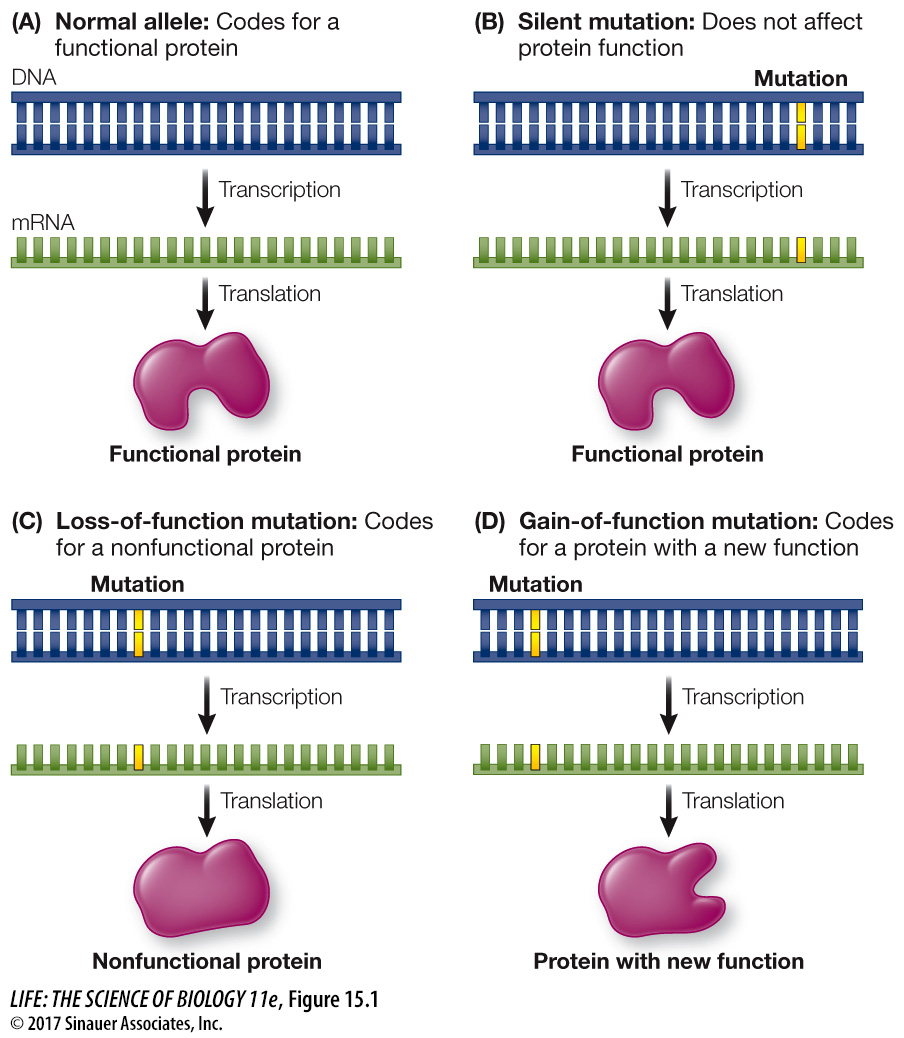Mutations have different phenotypic effects
Mutations are classified generally by the type of cell in which they occur:
Somatic mutations occur in somatic (nongamete) cells. These mutations are passed on to the daughter cells during mitosis, and to the daughters of those cells in turn, but are not passed on to sexually produced offspring. For example, a mutation in a single human skin cell could result in a patch of skin cells that all have the same mutation, but it would not be passed on to the person’s children.
Germ line mutations occur in the cells of the germ line—
the specialized cells that give rise to gametes. A gamete with the mutation passes it on to a new organism at fertilization. The new organism will have the mutation in every cell of its body and will be able to pass the mutation on to its offspring. The BRCA1 mutation that Angelina Jolie, her aunt, and her mother inherited from Angelina’s grandmother is a germ line mutation.
Does every mutation have a phenotypic effect? Not necessarily. Some mutations have effects on proteins and their function, and some do not (Focus: Key Figure 15.1):
A silent mutation does not usually affect protein function (see Figure 15.1B). It can be a mutation in a region of DNA that does not encode a protein, or it can be in the coding region of a gene but not affect the amino acid sequence. Because of the redundancy of the genetic code, a base change in a coding region will not always cause a change in the amino acid sequence when the altered mRNA is translated (see Figure 15.2). Silent mutations are common, and they usually result in genetic diversity that is not expressed as phenotypic differences.
A loss-
of- function mutation affects protein function (see Figure 15.1C). Such a mutation may cause a gene to not be expressed at all, or the gene may be expressed but produces a dysfunctional protein that can no longer play its cellular role, such as its catalytic function if it is an enzyme. Loss- of- function mutations almost always show recessive inheritance in diploid organisms, because the presence of one wild- type allele will usually result in sufficient functional protein for the cell. For example, recall from Key Concept 12.1 that the familiar wrinkled seed allele in pea plants, originally studied by Mendel, is due to a recessive loss- of- function mutation in the SBE1 (starch branching enzyme) gene. Normally the protein made by this gene catalyzes the branching of starch as seeds develop. In the mutant, the SBE1 protein is not functional, and that leads to osmotic changes, causing the wrinkled appearance. A gain-
of- function mutation leads to a protein with an altered function (see Figure 15.1D). A gain- of- function mutation usually shows dominant inheritance, because the presence of the wild- type allele does not prevent the mutant allele from functioning. This type of mutation is common in cancer. For example, there are mutations in oncogenes that result in proteins that constantly stimulate cell division.
focus: key figure

Question
Q: For a protein coding gene, which of the three types of mutation will be most common, and why?
Silent mutation, because the genetic code is redundant (many mutations do not change the amino acid translated) and because many amino acids in a protein are not essential for the activity of the protein (e.g., do not affect the active site).
Activity 15.1 Gene Mutations and Function Simulation
www.life11e.com/
Activity 15.2 Point Mutations Simulation
www.life11e.com/

Some mutations have effects on phenotype only under certain conditions. For example, a conditional mutation affects phenotype only under restrictive conditions and is not detectable under what are called permissive conditions. Many conditional mutations are temperature-
Most point mutations can be reversed; reversion mutations result when a gene is mutated a second time so that the DNA reverts to its original sequence or to a coding sequence that results in the non-
Now let’s look more closely at the DNA level to see how various kinds of mutations play out.